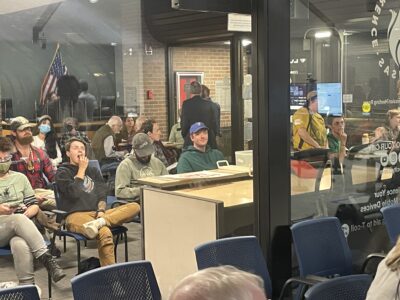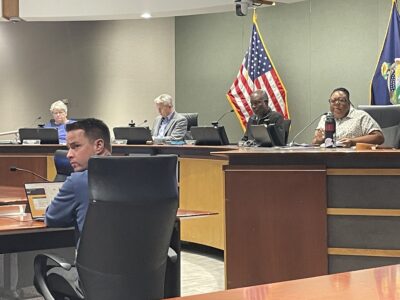Lawrence city commissioners approve new Land Development Code after dozens of commenters urge them to press pause

photo by: Bremen Keasey
Dozens of people gathered outside a packed City Commission meeting room at Lawrence's City Hall Tuesday night before the commission meeting, with some holding signs saying "No Residential Upzoning." Several dozen residents spoke out against a new Land Development Code that commissioners are considering.
Lawrence city commissioners approved a sweeping new Land Development Code for the city on Tuesday, after most of the nearly 50 people who spoke about it during public comments urged the commissioners to “take a pause” on approving it.
The commission voted 4-1 to approve the new code, with Commissioner Lisa Larsen providing the lone “no” vote. The commission added a few amendments clarifying additional edits to the document and providing more direction to the planning department, which required a supermajority to pass.
The city had been working with a consulting firm, Clarion Associates, to draft a new code that would better reflect Plan 2040, the city’s long-term strategic plan. The current code has not been updated since 2006, and this draft of the Land Development Code was presented to the City Commission Tuesday night as the culmination of a two-year plan.
As part of the process of creating the new document, the city formed a Land Development Code Update Steering Committee that met 18 times since 2022. The Planning Commission also held 17 study sessions about the development code, with each making drafts and edits during each of those meetings. This final code was approved on Oct. 23 by the Planning Commission on a 6-3 vote, with a few adjustments to specific wording in some sections.
Generally, many of the stated goals of the new development code have been to streamline the code to make it less confusing for developers and to allow for a more diverse housing stock by changing the regulations to make denser housing options available. As an example, tweaks to zoning rules in some neighborhoods would allow for the creation of accessory dwelling units — a secondary housing unit on a single-family residential lot — in new places where they weren’t allowed before, with the idea of creating more smaller units.
Those changes to increased housing density and the effects it could have on the neighborhoods were the biggest concerns of those who spoke out during public comment.
Commenters said they were worried that the rules encouraging more density could lead to developers coming in to buy up single-family housing and convert it into student housing, and they said the general changes to increase density would negatively impact the fabric of Lawrence’s neighborhoods. One person said the increased density rules could serve like a “blunt ax” against neighborhoods, especially in areas close to the University of Kansas campus and downtown.
A real estate agent who spoke during public comment said he felt the new zoning plan would “remove the guardrails currently in place” that protect some of Lawrence’s core neighborhoods and could greatly change the fabric of them. Another commenter asked: “How can you assure that the code won’t negatively affect neighborhoods?”
Others felt the code was not complete and could have loopholes that make it easier for developers to buy up homes. Many commenters urged the commissioners to send the code back to the Planning Commission for consideration. Mandy Enfield, the president of the University Place Neighborhood Association, said passing the code would take a “ready, fire, aim approach.”
Bobbie Flory, the executive director for the Lawrence Home Builders Association, said during public comment she felt the group constructing the new development code did a good job for the most part, but said that it could be better to “permit” housing density instead of mandating it. Flory said there is a risk that some future buyers may not desire homes that are built in densely developed neighborhoods.
“Builders are not going to build a product buyers won’t buy,” Flory said. “If we’re over-anticipating density, nothing will get built.”
Garvin acknowledged the concerns about increased density had been a key discussion topic throughout the process. Some edits to the code — like adding an exception for areas zoned as “R-2” that states single-family houses would not need to meet required minimum density rules if rebuilt or reconstructed — seem to address some concerns.
Rob Richardson, who works for the Douglas County EDC, a group that advocates for prosperity and investment in Douglas County, was one of the few people who spoke in favor of the land development code. He said because Lawrence “needs more housing,” adding more density will allow for that.
The increased allowance to density also created concern for residents about a possible lack of parking in the area due to more people moving in. An initial draft of the code would have removed required parking minimums and instead implemented parking maximums, as the Journal-World reported in July. Although the draft was changed to keep residential parking minimums, a handful of residents during public comment asked for the removal of those parking minimums.
The draft has since been changed to keep in minimums for residential parking but with lower numbers than before. A handful of residents during public comment Tuesday night urged for the removal of those parking minimums.
The start date for the code is set for April 1, 2025, with a first round of “revisions and corrections” expected to come later in the year.
In other business, the commission approved a special use permit that would allow the addition of 24 Pallet shelters behind the Lawrence Community Shelter.
As the Journal-World previously reported, the Planning Commission unanimously approved the request back in October. The proposal would add the cabins, an office space and two hygiene units behind the main building at 3655 E. 25th St., increasing the shelter’s capacity from 125 people to 173. The site plan also set aside space for six additional cabins in the future.
In February, the city opened The Village at 256 N. Michigan St., which includes 50 Pallet cabins and is run by the shelter.
The cost of the project is yet to be finalized, but the shelter board asked for about $700,000 in additional funding from the city in June. A portion of that would help create the new Pallet project.
Editor’s Note: This article was edited to correct the spelling of Bobbie Flory’s name, and to clarify her remarks to the commission. Flory did not express any doubt about Lawrence’s projected need for additional housing in the future, but rather raised questions of whether the development code was overestimating the future demand of buyers to locate in densely developed neighborhoods.







